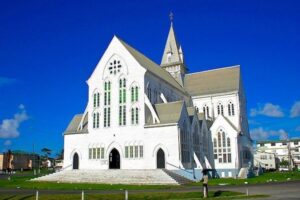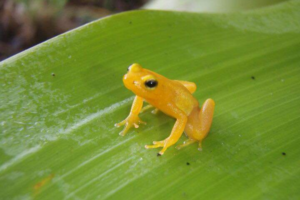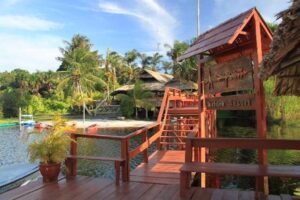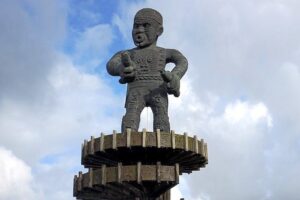Guyana really does offer something special — a small South American country nestled on the Atlantic Coast east of Venezuela and west of Suriname, it is one of the last unexplored wild places on earth yet offers incredible access into a great variety of pristine habitats. It is also a land of great contrasts as you leave behind the coastal city of Georgetown travelling into the interior, over vast unspoilt forests and incredible isolated waterfalls.
The lure of Guyana is its pristine habitats and true wilderness where amazing wildlife with many sought-after species easier to see here than in any of the surrounding countries. We have put together the most complete itinerary available, which includes visit to all the top eco destinations across the country and most importantly where highly favoured rarities are found, such as Blood-coloured Woodpecker, Rufous Crab Hawk, White-bellied Piculet, Grey-winged Trumpeter, Black Crassow, Cayanne Jay, Guianan Red Cotinga, Rufous-winged Ground-Cuckoo, Crimson Fruitcrow, Rufous Potoo, White-winged Potoo, Harpy Eagle, Crested Doradito, Bearded Tachuri, Sun Parakeet, Rio Branco Antbird and the Hoary-throated Spinetail.
We only use the very best local guides and you can rest assured that your money will go to help Guianan-owned lodges and local communities. If you want to see the Guianan Shield Endemics including the Guianan Cock-of-the-Rock, cotingas, parrots, macaws and the bizarre Capuchinbird and an endless supply of mouth-watering species then this could be your best trip ever! We offer the No. 1 trip to this fabulous country.

Today is planned as an arrival day. Flights to Georgetown, Guyana. International flights usually arrive after dark at the recently renovated Cheddi Jagan International Airport, located 25 miles south of the capital city, Georgetown. You’ll be met at the airport by a representative from our ground agent (who should be carrying a sign with your name/s and “Cultural Earth Tours” on it). and transferred by bus directly to our comfortable hotel. The journey will take about an hour (it may vary one way or the other, depending on your flight arrival time). If you cannot arrange a flight that arrives before dinner time, we strongly recommend that you plan to arrive for the tour a day early. Those arriving on late flights tonight are unlikely to arrive to the hotel well after midnight and we have a very early (5:00 am) departure tomorrow. Overnight at Cara Lodge Hotel

This morning we’ll leave our hotel at 5:00 AM (having downed a cup or two of caffeine to help us get started!) and heading eastward along the Atlantic coast, we’ll make a few stops to check out the mud flats for Scarlet Ibises as they set out to feed at dawn. We’ll continue towards the community of Mahaica where we’ll take a boat trip along the river. Among our targets will be Guyana’s national bird, the bizarre, primitive Hoatzin, which is found in abundance in the dense vegetation along this system. We’ll also look for a host of other species including the Rufous Crab Hawk (localized), Black-collared Hawk, Black Hawk-Eagle, Long-winged Harrier, Barred Antshrike, Silvered Antbird, Striped Cuckoo, Little Cuckoo, Green-tailed Jacamar, Blood-coloured Woodpecker, White-bellied Piculet, and Mangrove Cuckoo. Depending on the level of the tide, we may be able to check the shoreline for birds such as Scarlet Ibis, White-rumped Sandpiper, White-cheeked Pintail, Western Sandpipers, Whimbrel, Black-bellied Plovers, Short-billed Dowitcher, Tricolored Heron, Yellow-crowned Night-Heron, Little Blue Heron, Magnificent Frigatebird, Royal, Gull-billed and Least Terns, and Brown Pelican. We will return to our hotel for a late lunch.
After lunch in Georgetown, we’ll visit the Georgetown Botanical Gardens, an area of parkland with open grass, scattered trees, bushes and several ponds and wet areas. Here our target bird would be the Festive Amazon as they come in to feed on fruiting trees during the evening, we also have a second chance of seeing several special birds including Blood-colored Woodpecker, White-bellied Piculet, the gorgeous Spotted Tody-Flycatcher, Rusty-margined Flycatcher, Southern Beardless, Great-horned Owl, Lesser Kiskadee, Black-capped Donacobius, Yellow Oriole, Yellow-chinned Spinetail, Wing-barred Seedeater, Straight-billed Woodcreeper, Black-collared Hawk, and plenty of Snail Kites. In the tree tops, we’ll hope to see Red-shouldered Macaw, Orange-winged, Yellow-crowned and Mealy Amazons, and, with luck, the Festive Amazon, a species in serious decline due to the illegal pet trade. If the trees are flowering, we’ll search for hummingbirds such as Black-throated Mango and White-chested Emerald and Plain-bellied Emeralds. Overnight at Cara Lodge Hotel (B, L, D)

After breakfast at our hotel, we will take a chartered flight over unspoilt pristine forest to Kaieteur Falls, the world’s highest free-falling waterfall. Though Venezuela’s Angel Falls is greater in total height, its filamentous drop occurs by stages, whereas Kaieteur is a single massive, thundering cascade 100 meters wide, created as the Potaro River makes a sheer drop of 228 meters, nearly five times the height of Niagara Falls. The spectacle is even more impressive for its remoteness. It is altogether possible that we’ll be the only persons viewing it. Here, we will hope to find White-chinned and White-tipped Swifts swirling over the gorge, and perhaps we’ll be lucky enough to have our first sighting of the astonishingly colorful Guianan Cock-of-the-Rock and see an Orange-breasted Falcon as it hunts for its favorite prey, the swifts. We should also be able to find the rare and endemic Golden Rocket Frog that lives in water held in the leaves of giant bromeliad plants. Our flight departure time is dependent on the weather conditions. There will be plenty of bottled water, soda drinks, sandwiches, nuts, and crackers for lunch. Weather willing, after a 2-hour stop at the falls, our flight will continue to Fairview Village where we’ll be transferred to Iwokrama River Lodge in the heart of Guyana’s beautiful rainforest. Arriving at the lodge by 3 pm, we’ll settle into our accommodations before enjoying a late lunch and prepare for the afternoon birding excursion on the nearby trails. During the late afternoon we will head out on the road before dark. This will be our first opportunity to see the White-winged Potoo. Our guides know of areas where these birds occur and have been seen on all our trips. Returning after dark will give us the opportunity for night spotting, there is good chances to spot a Jaguar, Tapir, Anaconda, Ocelot, Puma (Mountain Lion) and Even a Kinkajou. This impressive surrounding forest protects a unique ecosystem in the heart of the Guianan shield where Amazonian and Guianan flora and fauna form one of the highest species biodiversity in the world. Our comfortable lodge has modern cabins each with balconies that overlook the beautiful Essequibo River. There will be plenty to look at with Pied Lapwings, Black-collared and White-winged Swallows over the river, and a host of species in the surrounding forest edges. With luck we may come across Spotted Antpitta, Rufous-capped Antthrush, Ringed and Waved Woodpeckers, Slaty-capped Shrike-Vireo, Helmeted Pygmy-Tyrant, Black-necked and Green Aracaris, Guianan Toucanet and possibly Red-rumped Agouti or a family of Red Howler Monkeys. Overnight at Iwokrama River lodge (B,L,D)

After early breakfast this morning, we’ll take a short ferry trip across the Essequibo River and head for a large patch of white sand forest on the opposite side. Growth of this poor soil is markedly different from that of the surrounding rainforest trees: Trees here are stunted, shorter and thinner but their growth can be quite dense. This unique habitat offers a variety of white sand specialists, including Black-headed Antbird, Wing-banded Antbird, Grey-winged Trumpeter the Black Manakin, Rufous-crowned Elaenia, Saffron-crested Tyrant Manakin, Pale-bellied Mouner, Bronzy Jacamar, Sapphire-rumped Parrotlet, Lilac-tailed Parrotlet, Black-throated Antbird, Spot-winged Antbird, Double-banded Pygmy Tyrant, Pelzin’s Toddy Tyrant, Red-Shouldered Tanager, Guianan Shiffornis, McConnell’s Flycatcher, Rufous-tailed Flatbill, Plain-crowned Spinetail, Dusky Parrot, Red-fan Parrot, McConnel’s Flycatcher, Blue and Yellow Macaw, found only in this unique habitat of the Guianas, and (with luck) the stunning Guianan Red Cotinga or the even more stunning Crimson Topaz and Red-billed Woodcreeper. We’ll return to our lodge for lunch and a break.
In the afternoon, we’ll walk one of the forest trails, with hope of finding an active swarm of army ants leading us to a Rufous-winged Ground-Cuckoo, a Spotted Antpitta, White-plumed Antbird, Rufous-throated Antbird, Amazonian Pygmy-Owl, Black-faced Hawk, Guianan Trogon, Mottled Owl, Crested Owl, Northern Tawny-bellied Screech Owl and the Ferruginous-backed Antbird a Chestnut-rumped Woodcreeper which are all possible in the area. Overnight at Iwokrama River Lodge (B,L,D)

This morning, departing River Lodge after an early breakfast, we’ll bird on the road along the way to our next destination, the Atta Rainforest Lodge. Some forest birds are very elusive and hard to see, however, this drive will allow us the chance to look for Black Curassow, Grey-winged Trumpeter, Guianan Toucanet, Guianan Red Cotinga, Puprle-breasted, Pompadour, and Spangled Cotingas. Canopy flocks can also produce, Ash-winged Antwren Buff-cheeked Green, Lemon-chested Greenlet, Olive-green Tyrannulet, Zimmers Flatbill, Guianan Tyrannulet, Yellow-throated Flycatcher and Guianan Puffbird, En route we’ll check a roost spot for a long-staying Rufous Potoo, a poorly-known species only rarely seen by birders. We’ll arrive to our lodge in time for lunch. Atta’s hummingbird feeders and pollinator garden should keep us well entertained as we eat, bringing in long-tailed and Reddish Hermit, Black-eared Fairy, Grey-breasted Sabrewing, Forked-tailed Wood-nymph, Racket-tailed Coquet and the magnificent Crimson Topaz. After a bit of a break (which many of us may spend on benches in the lodge clearing, where a host of species can be seen), we’ll bird along the lodge’s drive way as far as the main hightway, hoping to run into large mix flocks that sometimes work along the track’s edge. Towards dusk, we’ll hop in our vehicles to drive a bit further along the road. Our target tonight will be Black-banded Owl, though spectacle and crested owls, as well as Blackish nightjars, are also possible. Overnight at Atta Rainforest Lodge (B,L,D)

We’ll have a whole day to bird the Lush Iwokrama Rainforest. Before breakfast, we’ll take a trail out to tta’s canopy walkway, where we’ll climb the 120+ steps to the towers and spend some time watching for canopy dwellers, if we’re lucky, Todd’s Antwren, Spot-tailed Antwren, Short-tailed Pygmy-Tyrant, Guianan Toucanet, Green Aracari, Painted Parakeet, Caica Parrot, Black-headed Parrot, Guianan Puffbird, Dusky Purpletuft, Paradise Tanager, Opal-rumped Tanager, Golden-sided Euphonia, Purple and Green Honeycreepers, Black-faced Dacnis, Green Aracari, Guianan Toucanet, and Black Nunbird to name a few. After breakfast, we’ll spend the remainder of the morning searching the many remarkable birds that make this area home, Black Curassow, Marail Guan, Waved Woodpecker, Red-necked Woodpecker, Golden-collared Woodpecker and Ringed Woodpecker.This wonderful area is famed for its variety of colorful cotingas and if we can locate a few fruiting trees we will be in for an avian spectacle with possibilities of Pompadour, Purple-breasted, and Guianan Red Cotingas, as well as White Bellbird and the outrageous Crimson Fruitcrow. Gray-winged Trumpeter, Cayenne Jay, Amazonian Barred Woodcreeper, Red-billed, Ferruginous-backed Antbird and the minute Painted Tody-Flycatcher. During the afternoon a short walk will lead us to a small stream crossing where we’ll watch for Rose-breasted Chat, Guianan-streaked Antwren, Crimson Topaz, Black-chinned Antbird, Dusky Antbird, Cinnamon-throated Woodcreeper, and Chapman’s Swift. Overnight at Atta Rainforest Lodge (B,L,D)

After a final breakfast at Atta Rainforest Lodge, we’ll make the drive to Surama Village, home to the Makushi people and our-local-guide-with plenty of birding stops en-route some possibilities are Marail Guan, Green Aracari, Guianan Puffbird, Dusky Purpletuft, Black-spotted Barbet, Harpy Eagle, Crested Eagle, Ornate Hawk-Eagle, Black Hawk-Eagle, Tiny Hawk, Black and White-Hawk Eagle, Black-bellied Cuckoo, Green Oropendola, and Crimson Fruitcrow. On this drive we also have good chances of spotting one or of our wild cats, (Jaguar, Puma or Ocelot) are all possibilities. Once we’ve had our fill of morning birding, we’ll continue on to the Surama Eco Lodge, which sits near rich rainforest punctuated by the rugged Pakaraima Mountains.The accommodations are rustic but comfortable, with a mix of traditional benab-style huts (all with en-suite bathrooms). Late in the afternoon we will brid along the Great Potoo trail where we hope to see a Great Potoo or two roosting in good light. Additional species we may find, Little Chachalaca, Grassland Sparrow, Wedge-tailed Grass-Finch, Forest Elaenia, White-throated Toucan, and Fork-tailed Palm-Swift Finch’s Euphonia, Scarlet Macaw, Striped Woodcreeper, Spotted Puffbird, King Vulture and time permitting we will try for the Ocellated Crake. At dusk, White-tailed Nightjar, Least Nighthawk, Lesser Nighthawk, Tropical and Tawny-bellied Screech-Owls will be quite likely. Overnight at Surama EcoLodge (B,L,D)

Surama Village is known as the raptor haven, with its unique habitats, a small open grassland surrounded by primary tropical rainforest and mountains, your chances here to see the world’s most powerful Eagle or any of the one listed below are highly probably. There are three known active Harpy Eagle nests close the community and are within walking distance of each other. We’ll dedicated this day to seeing the Harpy Eagles at their nesting tree. A 30-minute drive from Surama Eco-Lodge will bring us to the Harpy Eagle nature trail. We’ll walk for an hour on a flat trail through the forest and hope to see the Harpy at their nest. If they are not there, we will wait for them to return from hunting. On past trips, we have witnessed the adults bringing in their prey including monkeys, sloths, iguanas, macaws, and the Red-rumped Agouti. There is also a stake out Long-tailed Potoo roost, and Northern Tawny-bellied Screech Owl, White-throated Manakin lek is also visible on the trail, in the canopy you can find Capuchinbird at their lek. This is also a good day to ketch up on some skulkers, Rufous-bellied Antwren, Collared Puffbird, White-crowned Manakin, Cinnamon-crested Spadebill, Scale-backed Antbird, and White-plumed Antbird. We will have lunch at the Surama Junction with our host and chef Madonna Allicock. After our delicious lunch we will return to the lodge. Overnight at Surama EcoLodge (B,L,D)

Today is our final morning birding forest trails near Surama. We will visit a nearby Ornate Hawk-Eagle nest. This will give us the opportunity to look for understory skulkers such as Ruddy Quail- Dove, Rufous-throated Antbird, Spotted Antpitta, Black-throated Antshrike and Rufous-bellied Antwren. After a good morning of final birding near Surama area, we’ll continue our journey to our next destination which is Rock View Lodge, trading the vast Iwokrama Rainforest Reserve and Surama Village for the wide-open Rupununi Savanna. This drive usually take us about 45 minutes, though we’ll do some birding along the way. Some, birds we may see on the drive incudes, White-naped Xenopsaris, Plumbeous Seedeater, Bicolored Wren, Gray Seedeater, Grassland Yellow-Finch, Yellowish Pipit, White-fringed Antwren, Crested Bobwhite, White-throated Kingbird, Vermillion Flycatcher, the colorful Orange-backed Troupial, and the agile Aplomado Falcon. Overnight at Rock View Lodge (B,L,D)

The Rupununi savanna is an extensive flatland that projects south to the border with Brazil. It hosts extensive tropical grasslands and areas with scattered trees (savanna) as well as shrubs and scrubby vegetation. Ecologically speaking, it is part of a series of savannas separating the forest of two immense biomes, the Orinoquian and the Amazonian. Despite its apparent homogeneity, there are various microhabitats where highly specialized birds are found. For this reason, we will invest our morning checking wetlands and scrubby vegetation where we might come across a Pinnated Bittern in the muddy bank of a pond while in tall grasses we may find the cute Bearded Tachuri and Crested Doradito. In the meantime, the White-tailed Goldenthroat (hummingbird) could be seen visiting flowering plants near or inside shallow wetlands while the widespread Burrowing Owl will be standing in areas that never get flooded. We will also explore the short seasonal grasses for pairs of Buff-necked Ibis or the dull Yellowish Pipit that may be singing there. Apart from the birds, this extensive area will be a good bet to look for the Giant Anteater. Other open country birds we might come across include Aplomado Falcon, Pearl Kite, White-tailed Hawk, Double-striped Thick-Knee, Maguari Stork, Azure Gallinule and Jabiru. After a good morning of birding in open country, we’ll enjoy a pack lunch before making our way back to our lodge. During the afternoon, after a rest birding will be done around the property before dinner. Overnight at Rock View Lodge (B,L,D)

The day will begin with our enjoying a very early breakfast ahead of a morning drive to Karasabai, an Amerindian village in the foothills of the Pacaraimas where the astonishingly beautiful Sun Parakeet is found. This area is a good example of a bird conservation project hosted by a local community. Once almost wiped-out of the region by intense trapping for the pet trade, the population of the parakeet has begun to rebound under the protection of the Karasabai community. We are likely to spend some time learning from the local community about this successful conservation program. We will also look for distinctive subspecies of the White-bellied Piculet and Yellow-hooded Blackbird, which may soon be elevated to full species status, Hooded Siskin, Toco Toucan and ferruginous Pygmy-Owl are also present. After lunch, we will bird our way back across the savannas to Manari Ranch, near the out skirts of Lethem looking for open country birds including Aplomado Falcon, Pearl Kite, White-tailed Hawk, Double-striped Thick-Knee, Maguari Stork, Azure Gallinule, and Jabiru. The drive will likely to take all afternoon, but in the comfort of Manari Ranch, we will relax and enjoy an early dinner. At dusk we’ll watch the skies for Lesser, Least and Nacunda Nighthawks leaving their roosting sites for their foraging grounds. Overnight at Manari Ranch (B,L,D)

Our last morning in the field will again find us on the road before dawn, driving to a dry scrub forest along the Takutu and Ireng rivers, which form Guyana’s southwestern boundary with Brazil. Our target species will be two poorly known and very local endemic species: Hoary-throated Spinetail and Rio Branco Antbird. Another possibility is the spritely Chestnut-vented Conebill, which travels in small but active groups through the riverine forest. We will also look for Crestless Curassow (can be difficult to locate), Pearl Kite, Aplomado Falcon, Rufous-tailed Jacamar, White-throated Kingbird and Flavescent Warbler. Lunch will be at Manari followed by a short 20-minute drive to Lethem where we will catch the one-hour commercial flight to Georgetown. Overnight at Cara Lodge (B,L,D)
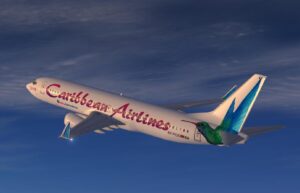
Depending on the timing of your international return flight, we’ll arrange for your airport transfer accordingly. Please remind us of your timelines. A group transfer will be easier but, but for participants leaving on different flights we will be able to arrange that transfer as well. “Thank you for choosing Cultural Earth Tours as your first choice of travel. Have a Fabulous, enjoyable and memorable tour with us”
14 Days / 13 Nights
$6,985USD per person based on single occupancy
Discounted rates available for large or small groups – please enquire.
INCLUDED
- One International Airport Transfer arrivals and departures by (Car or mini vans)
- Ogle Airport transfers (this is local charter and schedule flight airport)
- Double or twin accommodation, bed & breakfast (B&B)
- Single room/cabin supplement, bed & Breakfast (B&B)
- Meals as listed on the itinerary breakfast, lunch, dinner (B,L,D)
- All meals from day one, as indicated
- Bottled water, soda drinks, diet coke etc. daily
- Light snacks, cookies, crackers, nuts, sandwich
- All road and river transfers
- Internal flights in Guyana (charter and schedule flights)
- Activities as described on our itinerary
- 14%VAT – on all payments for tours
- Tour Leader
NOT INCLUDED
- Items of a personal nature
- Alcoholic drinks
- International flights
- Tourist Visa if needed
- Emergency evacuation insurance
- Tipping/gratuity
This tour can be operated on demand. We usually require 45 days advance notice to secure bookings and reservations.

MARISSA IRONS, FOUNDER
I was born in Georgetown the capital city of Guyana. My mother is from the Makushi and Arawak tribe, two of the nine Amerindian tribes native to Guyana. She was born in a small village called Tipuri it is located in the upper Takutu-upper Essequibo region of Guyana. It was from my early years on a ranch that was surrounded by mountains, forest, and wildlife that my love and appreciation for our culture, environment and wildlife began.
Insurance
The purchase of trip cancellation insurance is strongly recommended. Cultural Earth Tours cannot accept liability for airline cancellations or delays, or penalties incurred by the purchase of non-refundable airline tickets or other expenses incurred by tour participants in preparing for this tour.
Travel Planning
You are responsible for arranging your flights to and from Georgetown. Plan to arrive in Georgetown in good time for a good rest before our early morning departure on day two.
Notice
Please be advised that all tour participants must complete our Guest Information Form upon confirming your booking.
It is necessary that all tour participants booked to travel on tour with us in Guyana provide the basic information to minimize any delays. Failure to provide us with this information or the incorrect information can cause delays to flights and inconvenience to other passengers and in some cases either passengers and/or luggage being taken off the flights. To ensure a tour that is enjoyable and hassle free, it is imperative that passengers provide us with this information. We appreciate some people are sensitive about providing their body weights, but all customers and their baggage are weighed at check-in. This is a procedure by the airline to ensure that the weight of the load is within the payload limit for the aircraft, and neither they nor Cultural Earth Tours will compromise on safety. All passengers are subject to removal of themselves or luggage from the flight if they are over the weight they provided and/or over the baggage allowance. Passengers are advised to provide a body weight with clothing similar to that which they would expect to travel in on the flight. Cultural Earth Tours cannot be held responsible for any passenger denied boarding or luggage not transported if they are over the weight provided. Weights supplied are provided to the airline in advance to ensure the flight is within the allowable payload.
Packing for travel
Internal Flights On our flights tour participants are allowed 20lbs luggage, including a small carry-on day pack with personal stuff in it for example, items of personal use Passport, Money, medication, camera, binoculars, and telescope.
Main Luggage The main luggage must be a compact medium size suitcase or travel bag with mainly your clothing, books, and other items that you may bring with you for your travel, this luggage will be sent by road on a minivan the evening before we depart Georgetown and will be delivered to our lodge before we arrive by plane.
Immigration
Please treat immigration checks as international standards e.g., no liquid, bug spray, cream etc. etc.
Body Weight
Your body weight includes your camera, binoculars, and scope. You stand on the scale with that.
Water
There is a problem with plastic bottles at the lodges, so we encourage you to please walk with your water bottle to be refilled at the lodges with clean filtered water. We try as much as possible to avoid taking too much plastic bottles with us. However, bottled water is provided on a daily basis along with some, diet coke, soda drinks and juice. Water will always be available for you on the tour.
Weather
100% humidity, a small umbrella and a poncho is recommended, and for your equipment, please bring protective gears for them. You will never be cold in Guyana, no need to bring cold clothing.
Clothing & footwear
Light material clothing that can dry quickly, long sleeve, shirt and trousers for trail walks and tour activities. No brightly colored clothing, you must bring clothing that blends with the forest. Ankle height hiking boots and sneakers, with socks. Bring your willies.
Electricity
All our lodges are equipped with solar power, with the standard USA outlets, however, when not using please switch off your lights or unplug your equipment from the electrical outlet to save the batteries.
Please carefully review our Cancellation Policies and Terms & Conditions prior to booking.
The list of target species including Guianan Shield Endemics:
- Sun Parakeet
- Hoary-throated Spinetail
- Guianan Toucanet
- Crimson Fruitcrow
- White-winged Potoo
- Crested Doradito
- Bearded Tachuri
- Sharp-tailed Ibis
- Green Aracari
- Black Curassow
- Hoary-throated Spinetail
- White-bellied Piculet
- Guianan Shiffornis
- Rufous Potoo
- Orange-breasted Falcon
- Black Nunbird
- Fiery-tailed Awlbill
- Blue-backed Tanager
- Harpy Eagle
- Capuchinbird
- Blood-coloured Woodpecker
- Guianan Red Cotinga
- Rufous Crab Hawk
- Red-and-black Grosbeak
- Pompadour Cotinga
- White-naped Xenopsaris
- Spotted Puffbird
- Rufous-winged Ground Cuckoo
- Rio Branco Antbird
- Guianan Warbling Antbird
- Olive-green Tyrannulet
- Guianan Puffbird
- Red-fan Parrot
- Blue-cheeked Parrot
- Red-billed Woodcreeper
- Grey-winged Trumpeter






